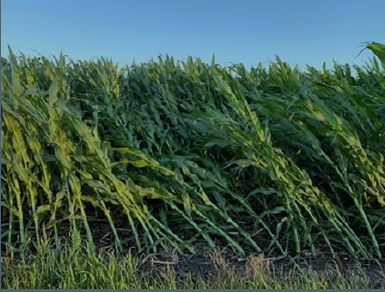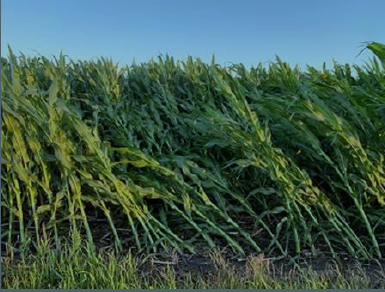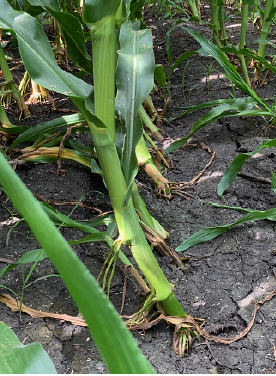Agronomy Update: Corn Tillering; Wind Damage to Corn; Downy Mildew on Soybeans
BY Dairyland Seed Agronomy Team
Corn tillering
Tillers, or “suckers,” are being observed in this year’s corn crop to a modest, maybe just average, occurrence. We see them every year to some degree, but the trick is in trying to develop a pattern to explain why they are occurring. It is a classic genotype by environment puzzle that can vary by season!
Like ear shoots, tillers are lateral branches of a corn plant. They typically appear near the soil line when corn is knee to waist high and are thought to occur as a result of favorable growing conditions. When the plants have ample resources (rain, fertility, etc) we are more likely to observe tillering. But there is a genetic component as well; we have all seen plot or side-by-side examples in which one hybrid is expressing tillers, and another is not.
Effects on yield seem to be negligible in most cases. The theory being that tillers develop when corn plants already have enough resources for the main plant. Recent studies have shown that tillers which do not form an ear will reallocate accumulated energy back to the main ear during grain fill, just like the leaves of the main plant. Silage quality might be an interesting case study in relation to tillering, but little information exists. We would speculate that there are more important drivers to silage quality than tillering, in most cases.
So far in 2021, the Dairyland Seed agronomy team has not picked up on any one hybrid that seems to be a tillering culprit. With a couple localized exceptions, observations from the field have resulted in cases from a variety of hybrids, many of them in not more than one occurrence. On a wide geographic scale, this year’s tillering appears to be driven more by environmental factors.
Wind Damage to Corn
Recent severe storms across parts of the Midwest have produced high winds, straight-line winds and tornadoes, which have had a negative effect on corn fields. Some of the damage to these corn fields include leaning plants and root lodging (uprooting). Assessment of the damage should not be done the day after the storm. It is recommended to wait about five days to accurately assess the damage and allow the plants to show whether or not they will recover.
|
Leaning plants in the vegetative stage should stand back up after a few days. However, during tasseling and silking, the plant’s ability to stand back up is reduced. Plants that are root lodged usually recover by goosenecking. Since the corn roots were blown in one direction, the stalk will grow back towards the sun which creates a goosenecked stalk. Leaning and root lodged plants may experience reduced pollination if the wind damage happened before or during pollen shed and silking. This is due to additional plant stress and silks being covered by leaves and stalks of neighboring leaning or lodged plants. |
|
|
|
|
Depending on the severity and number of damaged plants, it would be best to scout fields now and prepare a harvest plan. Harvest schedules should be adjusted so the fields with more damage are harvested once they reach maturity to avoid further loss. Harvesting against the angle of lodge will help lift the corn into the header. While out scouting try to identify any factors that might have contributed to the lodging. Check for feeding from Corn Rootworm larvae, reduced root development from soil conditions or compaction, and check to see if the planting depth was too shallow. Also, make note of any lodging that seems to be hybrid specific. Corn hybrids vary in their susceptibility to lodging so selecting hybrids that withstand root lodging will help in the future. If you have any questions, please contact your local DSM or Regional Agronomist. |
Downy mildew on soybeans
Areas that have experienced high humidity and temperatures have seen downy mildew, Peronospora manshurica, appear in soybean fields. Downy mildew can infect seedlings but is more common in late vegetative and early reproductive stages. Lesions on the top of the leaf are irregularly shaped, pale yellow and older lesions will be brown with light yellow margins. The spots will be visible on the underside of the leaf with gray, fuzzy fungal bodies within the margins of the lesions. Downy mildew infects younger leaves so lesions can be found in the upper canopy. Downy mildew rarely causes economic impact, but in severe cases can cause defoliation. Similar to Septoria brown spot, fungicide applications for downy mildew control alone have shown little to no return. If you have any further questions on downy mildew, please contact your Dairyland Seed DSM or Regional Agronomist.
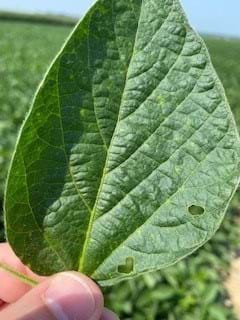 |
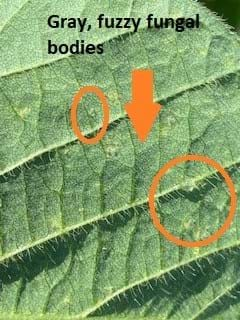 |
|
| Upper leaf surface | Underside of leaf |
Show off your field with dAIRYLAND SEED FIELD SIGNS
Signing your fields is a great way to promote Dairyland Seed products in your area. Field signs for corn, soybeans and alfalfa can be ordered by calling the Dairyland Seed headquarters at 800-236-0163 and ask to speak with Stacy Hendricks or Rita Frank.
cORTEVA TECHNOLOGY USE AGREEMENTS
All growers with orders for any Corteva Agriscience brand seed product, regardless of crop or trait (including non-GMO products) need to have a signed Corteva Technology Use Agreement in place by September 1. Growers should sign the Corteva Technology Use Agreement electronically at www.agcelerate.com. Signing electronically is preferable, however, paper copies are available at www.traitstewardship.com or by calling Rita Frank in the Dairyland Seed West Bend office at 800-236-0163.
 |
 |
 |
 |
 |
| Brian Weller Western Region 507.456.3034 |
Dan Ritter Central Region 219.863.0583 |
Branden Furseth Northern Region 608.513.4265 |
Mark Gibson Eastern Region 260.330.8968 |
Amanda Goffnett Eastern Region 989.400.3793 |

